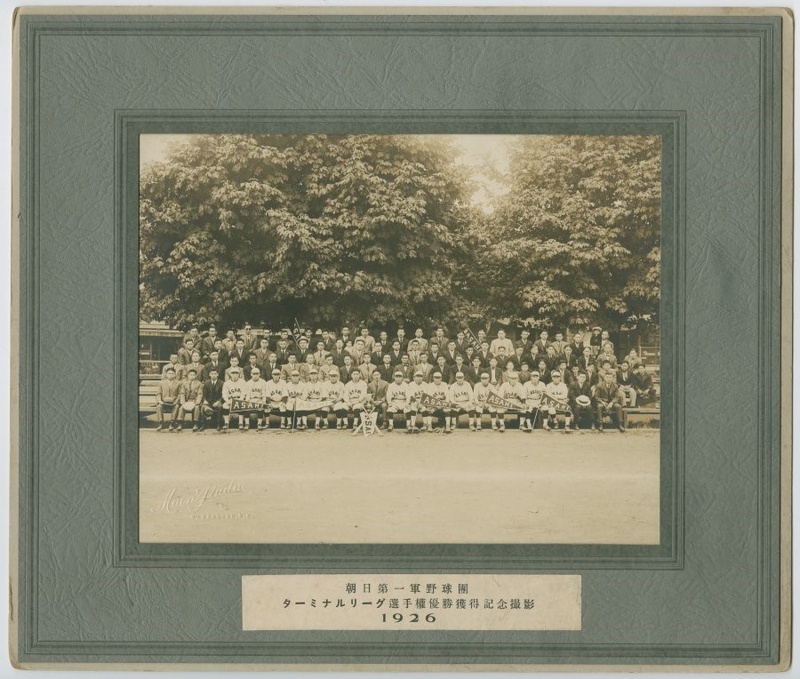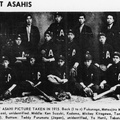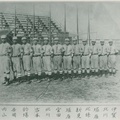
Kenichi Doi was a pitcher for the Vancouver Asahi baseball team in 1926 who originally played with the Cumberland baseball team on Vancouver Island B.C. Canada.
I am lucky that my friend Norm Ibuki introduced me to his close friend, George Doi, Kenichi Doi’s son, who shared his father’s history with me.
George was just a child during the height of Kenichi’s baseball days, so he does not have any memories of the actual games, other than getting into the back of an open truck to go to a game and watch it. In those days, everybody loved baseball—as a player or a spectator.
George did not know that his father Kenichi played for the Vancouver Asahi team until some years later, after his father had passed away. George’s uncle, Fred Tadao, told him how Kenichi was recruited, when the Asahi went to play in Cumberland. That was when they saw Kenichi pitching and asked him to come to Vancouver to play for the Asahi. They found a job for him at a sawmill, supposedly with a place to stay as well.
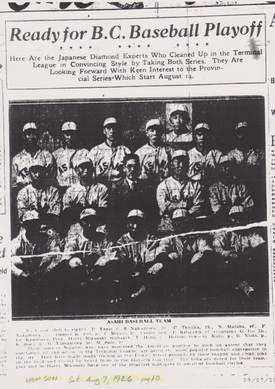
But Kenichi only played for the Asahi for one year, in 1926, since he got married after the championship that year and returned to his home in Cumberland. In 1927, when a wildfire razed their community, destroying their home as well as many others, Kenichi and his wife moved to Royston, which was about 5 km away. There, he found work and joined the Royston baseball team, made up of mill workers, coal miners, and loggers.
Here is a bit more background on Kenichi’s baseball years:
- Kenichi lived with his parents in a Japanese community close to the Number 5 coal mine, abutting the Cumberland City boundary. For the sake of simplicity, the community was named No. 5 - for instance, “Doi san wa numba 5 ni sunde imasu (Doi lives in the No. 5)”
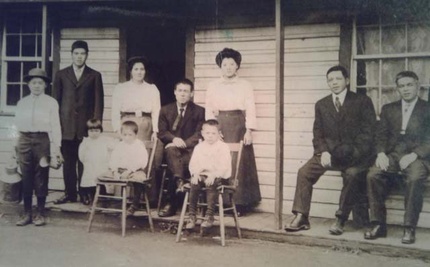
- Kenichi played for the No. 5 baseball team; the team’s name was ‘SUN.’
- The Japanese community of No. 1 was a little further away and had about 40 families. Their baseball team’s name was ‘NIPPON.’
- The combined NIPPON/SUN team won the Cowichan-Comox Valley Championships in 1922.
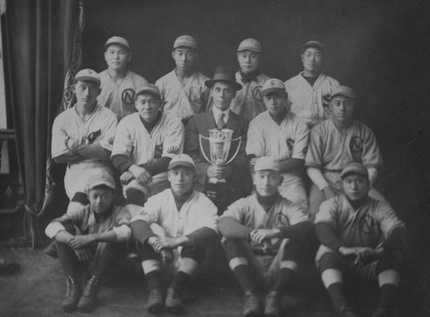
- In 1926, Kenichi played for the Vancouver Asahi as a pitcher, the year that they won their terminal league’s championships.
- Kenichi later joined the Royston team. They played all over Vancouver Island, against the lower mainland teams, and even into Washington state in the United States.
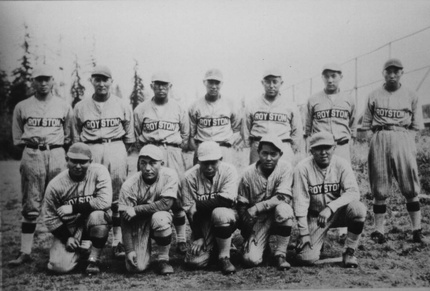
My dear friend, Yoichi Nagata, was kind enough to find a copy of a newspaper article from the Comox District Free Press, dated May 23,1935, which reported that Kenichi Doi took part in the game on Vancouver Island between the Twilight League All Stars and the Tokyo Giants, who were visiting Vancouver Island.
Kenichi Doi was not a pitcher but a second fielder in the game. The Tokyo Giants pitchers in that game were Toshihide Hatafuku , and then Eiji Sawamura. Victor Starffin, the famous Giants pitcher, did not take part in this game.
I have become aware that the ancestral families of Tom Matoba, Mickey Sato, Jack Hayami, George Shishido, Ken Nakanishi, Jo Fukui, James Fukui, and Kaye Kaminishi, all Asahi players in different years, were originally from Hiroshima, Japan.
Here are some more details of Kenichi’s job history before and during World War II.
Kenichi was born 1902 in Cumberland and completed the 4th or 5th grade.
At age 12, Kenichi was working at Kishimoto Dairy Farm (between Cumberland and Royston.) Every morning, he had to get up very early to milk the six cows before marching off to school.
After he quit school, he started working at a coal mine.
But Kenichi did not work too long in the coalmines. Due to the low pay and inherent danger from gas explosions, Kenichi went looking for employment in the logging industry, or doing mill work.
Kenichi told his son, George, a story about having a buddy who substituted his shift because Kenichi was ‘spiked’ and had a foot injury from playing baseball. That day, there was an explosion in the mine. George cannot remember if Kenichi told George what had happened to his friend, but several miners died. There is a photo of baseball players gathered at the Japanese cemetery to pay respects to the miners who were lost in this explosion.
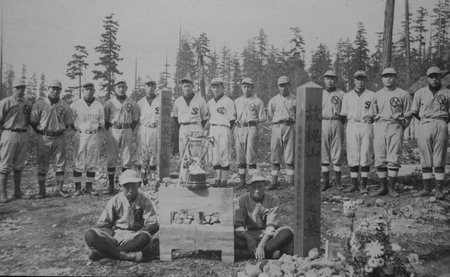
In the late 1920s, Kenichi started working at Royston Sawmill, the biggest sawmill owned by a consortium of Japanese. Kenichi worked there for about two years, but he didn’t like it, so he decided to work in the bush as a faller’s assistant and gradually worked his way up to become a head faller.
Falling in those days was complicated. The job was strenuous and definitely required lots of felling experience and experience with wedging trees. Safety was a great concern.
Kenichi’s logging work was mainly for the Royston Lumber Company. There was also a short period where he worked for his brother-in law, who had logging contracts.
In the Bay Farm Internment Camp, a small portable sawmill was set up, where Kenichi found work as a foreman.
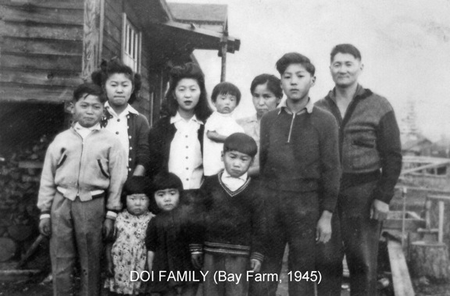
Due to labour shortages, internees were allowed to go outside the normally restricted areas to work. In 1944 and 1945, Kenichi and several others worked in logging camps and mills in Rogers Pass and Chapman Creek, both located near Golden, B.C.
When the camp closed, Kenichi’s son, George, then a fourteen-year old boy, started work in the logging camps to help support his parents and nine siblings. Later, he joined the British Columbia Forest Service, working in many ranger districts in Kootenays. He was promoted from Deputy Forest Ranger to the position of Forestry Operations Supervisor in the Vancouver Forest Region, and later to Fire Prevention Coordinator.
Kenichi died on July 17, 1981 in Slocan, B. C.
In closing, I would like to introduce a report written by Wylie Waters, Kenichi Doi’s great grandson, who participated in the Shin Asahi Team’s Japan Tour team in 2019.
- The Shin Asahi Japan Tour: Wylie’s Story — Asahi Japan Tour 2019
(Nikkei Place Foundation, June 6, 2020)
I am glad to feel the heritage of the Vancouver Asahi is still alive, and is being carried on.
Reference:
Cumberland Museum has many photos of local Nikkei baseball teams. Please check here.
* * * * *
Our Editorial Committee selected this article as one of his favorite More Than a Game: Nikkei Sports stories in. Here is the comment.
Comment by Yusuke Tanaka
As I was reading Yobun Shima’s “Family History of Kenichi Doi, Vancouver Asahi pitcher in 1926,” the past 30 years of my life with the Asahi flashed through my mind. This is a very valuable piece of family history. It’s a story of the Asahi’s history from 1914 to 1941, with bits and pieces of information collected through time. Who would have thought that their legacy would continue to expand its wings more than 100 years after the team’s birth?
As an editor, though, I should probably read the piece with an objective eye, but I don’t think that I ever spent a day without having the name “Asahi” cross my mind in the past 22 years of my life as an editor at Nikkei Voice since they hired me in 1989 and in the following 9 years after I became a freelancer. This is because Asahi baseball can be found in just about any place in Nikkei history, somehow always connected to its narrative.
In Yobun Shima’s story, he writes, “At age 12, Kenichi had to get up very early in the morning to take care of the cows at Kishimoto Dairy Farm, located near Royston, before marching off to school.” And according to Tokugi Suyama, who’s knowledgeable about the history of Cumberland, the farm owner Kishimoto ran a farm in Ontario, too, as he resettled there after being forced to move out. Those with the spirit of entrepreneurship had the power to quickly get back on their feet, even after losing their property.
There were some great autobiographies written by talented athletes, but since they have been published elsewhere, I chose Yobun Shima’s essay particularly for the reason that it synced with me in my career.
Yusuke Tanaka, a Japanese editorial committee member, wrote a memoir of the Asahi, as he read Shima’s story and immersed himself in the flashbacks of memories with the team. You can read his memoir here.
© 2020 Yobun Shima


